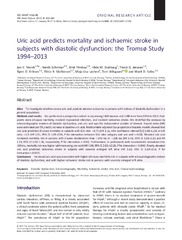Uric acid predicts mortality and ischaemic stroke in subjects with diastolic dysfunction: the Tromsø Study 1994-2013
Permanent link
https://hdl.handle.net/10037/11837Date
2017-01-31Type
Journal articleTidsskriftartikkel
Peer reviewed
Author
Norvik, Jon Viljar; Schirmer, Henrik; Ytrehus, Kirsti; Storhaug, Hilde-Merete; Jenssen, Trond Geir; Eriksen, Bjørn Odvar; Mathiesen, Ellisiv B.; Løchen, Maja-Lisa; Wilsgaard, Tom; Solbu, Marit DahlAbstract
Aims:
To investigate whether serum uric acid predicts adverse outcomes in persons with indices of diastolic dysfunction in a
general population.
Methods and results: We performed a prospective cohort study among 1460 women and 1480 men from 1994 to 2013. End- points were all-cause mortality, incident myocardial infarction, and incident ischaemic stroke. We strati fi ed the analyses by echocardiographic markers of diastolic dysfunction, and uric acid was the independent variable of interest. Hazard ratios (HR) were estimated per 59 μ mol/L increase in baseline uric acid. Multivariable adjusted Cox proportional hazards models showed that uric acid predicted all-cause mortality in subjects with E/A ratio < 0.75 (HR 1.12, 95% con fi dence interval [CI] 1.00 – 1.25) or E/A ratio > 1.5 (HR 1.51, 95% CI 1.09 – 2.09, P for interaction between E/A ratio category and uric acid = 0.02). Elevated uric acid increased mortality risk in persons with E-wave deceleration time < 140 ms or > 220 ms (HR 1.46, 95% CI 1.01 – 2.12 and HR 1.13, 95% CI 1.02 – 1.26, respectively; P for interaction = 0.04). Furthermore, in participants with isovolumetric relaxation time ≤ 60 ms, mortality risk was higher with increasing uric acid (HR 4.98, 95% CI 2.02 – 12.26, P for interaction = 0.004). Finally, elevated uric acid predicted ischaemic stroke in subjects with severely enlarged left atria (HR 1.62, 95% CI 1.03 – 2.53, P for interaction = 0.047).
Conclusions: Increased uric acid was associated with higher all-cause mortality risk in subjects with echocardiographic indices of diastolic dysfunction, and with higher ischaemic stroke risk in persons with severely enlarged left atria.
Methods and results: We performed a prospective cohort study among 1460 women and 1480 men from 1994 to 2013. End- points were all-cause mortality, incident myocardial infarction, and incident ischaemic stroke. We strati fi ed the analyses by echocardiographic markers of diastolic dysfunction, and uric acid was the independent variable of interest. Hazard ratios (HR) were estimated per 59 μ mol/L increase in baseline uric acid. Multivariable adjusted Cox proportional hazards models showed that uric acid predicted all-cause mortality in subjects with E/A ratio < 0.75 (HR 1.12, 95% con fi dence interval [CI] 1.00 – 1.25) or E/A ratio > 1.5 (HR 1.51, 95% CI 1.09 – 2.09, P for interaction between E/A ratio category and uric acid = 0.02). Elevated uric acid increased mortality risk in persons with E-wave deceleration time < 140 ms or > 220 ms (HR 1.46, 95% CI 1.01 – 2.12 and HR 1.13, 95% CI 1.02 – 1.26, respectively; P for interaction = 0.04). Furthermore, in participants with isovolumetric relaxation time ≤ 60 ms, mortality risk was higher with increasing uric acid (HR 4.98, 95% CI 2.02 – 12.26, P for interaction = 0.004). Finally, elevated uric acid predicted ischaemic stroke in subjects with severely enlarged left atria (HR 1.62, 95% CI 1.03 – 2.53, P for interaction = 0.047).
Conclusions: Increased uric acid was associated with higher all-cause mortality risk in subjects with echocardiographic indices of diastolic dysfunction, and with higher ischaemic stroke risk in persons with severely enlarged left atria.
Description
Source at https://dx.doi.org/10.1002/ehf2.12134


 English
English norsk
norsk